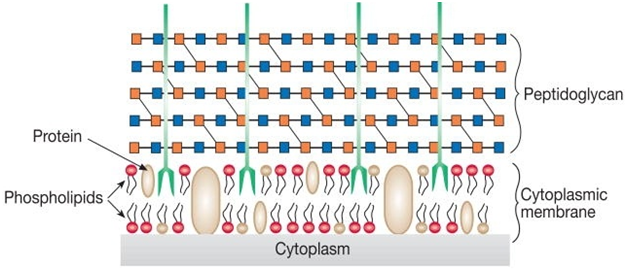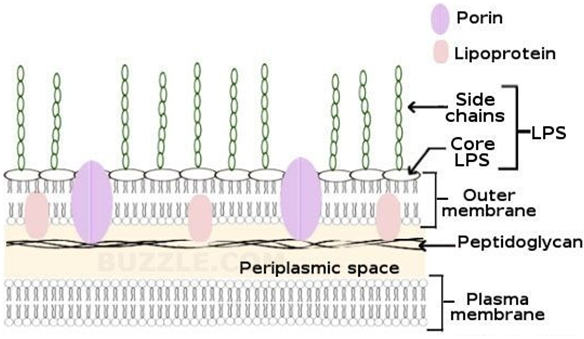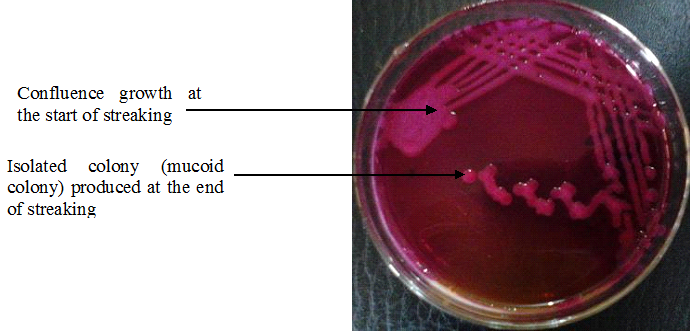Cell wall is a layer that is present outside the plasma or cytoplasmic membrane of a prokaryotic cell. It is present in both Gram-positive bacteria (Figure 1) and Gram-negative bacteria (2) even though some bacteria (e.g. Mycoplasmas) are wall-less i.e. they do not possess cell wall. Wall-less bacteria do not react to the Gram stain because they lack cell wall which contain cell constituents that differentiate bacteria into Gram negative and Gram positive bacteria.
Bacterial cell wall helps the organism to retain its shape in the face of unfavourable environmental conditions such as extreme chemical and physical changes. It is permeable to a variety of solutes. Bacterial cell wall maintains a mechanical function in the cell by enabling the cytoplasmic membrane to withstand its high internal osmotic pressure. Some of the basic functions of a cell wall in microbial cells (prokaryotic cells in particular) are as follows:
- The cell wall gives bacteria its characteristic shape.
- It protects bacteria from osmotic lysis.
- It protects the internal environment of bacteria from external shock, thus maintaining the cell’s integrity.
- Cell wall confers structural strength on bacteria, thus giving them support in their environment. This is seen when the cell wall is prevented from forming or destroyed by antimicrobial agents e.g. beta-lactam antibiotics- which makes the bacterial cell to swell and burst following the uncontrolled flow of materials in and out of the cell.
- Cell wall protects bacteria from toxic substances (e.g. antibiotics).
- Bacterial cell wall acts as receptor sites where other molecules bind.
Bacterial cell wall is a very important component of prokaryotic cells, and it divides bacteria into two major classes or groups: Gram-positive and Gram-negative bacteria based on bacteria reaction to Gram staining technique. The cell wall is a component of the bacterial cell envelope, and it lies between the plasma membrane and the capsule layer (for bacteria that form capsules). It is noteworthy that cell wall is a unique feature of prokaryotic cells and are rarely found in eukaryotic cells. Bacterial cell wall is of medical importance because it is the site of target for many antibiotics especially the beta-lactam drugs (e.g. penicillins and cephalosporins).


Gram-negative bacteria have a thin-layered peptidoglycan layer. The cell wall of Gram negative bacteria contains lipopolysaccharides (LPS) and outer membrane (OM); and both of these structures are lacking in the cell wall of Gram positive bacteria. Notice the thin-layered peptidoglycan component of the cell wall of Gram negative bacteria, another key difference between the cell walls of Gram negative bacteria and gram positive bacteria.
However, cell wall is absent in some prokaryotic cells such as the Mycoplasmas, L-form bacteria and some Archaea bacteria. To such prokaryotic cells without cell walls, antibiotics that target bacterial cell wall is of little or no therapeutic effects because the organisms are wall-less bacteria. Some of the major components that make up the cell wall of Gram-positive bacteria include peptidoglycan (murein), teichoic acid and polysaccharides. The Gram-negative cell wall is made up of lipopolysaccharides (LPS), outer membrane (OM), lipoprotein and a tiny peptidoglycan.
References
Alberts B, Bray D, Lewis J, Raff M, Roberts K and Watson J.D (2002). The molecular Biology of the Cell. Fourth edition. New York, Garland, USA.
Berg JM, Tymoczko JL, Stryer L (2002). Biochemistry (5th ed.). New York, NY: W. H. Freeman.
Brooks G.F., Butel J.S and Morse S.A (2004). Medical Microbiology, 23rd edition. McGraw Hill Publishers. USA.
Campbell, Neil A.; Brad Williamson; Robin J. Heyden (2006). Biology: Exploring Life. Boston, Massachusetts: Pearson Prentice Hall.
Cooper G.M and Hausman R.E (2004). The cell: A Molecular Approach. Third edition. ASM Press.
Dale J (2003). Molecular genetics of bacteria. Jeremy W. Dale and Simon Park (4th eds.). John Wiley & Sons Ltd, West Sussex, UK. Pp.
Karp, Gerald (2009). Cell and Molecular Biology: Concepts and Experiments. John Wiley & Sons.
Lodish H, Berk A, Matsudaira P, Kaiser C.A, Kreiger M, Scott M.P, Zipursky S.L and Darnell J (2004). Molecular Cell Biology. Fifth edition. Scientific American Books, Freeman, New York, USA.
Madigan M.T., Martinko J.M., Dunlap P.V and Clark D.P (2009). Brock Biology of microorganisms. 12th edition. Pearson Benjamin Cummings Publishers. USA. Pp.795-796.
Maton, Anthea (1997). Cells Building Blocks of Life. New Jersey: Prentice Hall.
Discover more from #1 Microbiology Resource Hub
Subscribe to get the latest posts to your email.


